After the Dark Ages the Dorians Rose Up and Began Again This Was the Beginning of What Age
The prehistory of Anatolia stretches from the Paleolithic era[1] through to the appearance of classical civilisation in the center of the 1st millennium BC. It is more often than not regarded equally being divided into three ages reflecting the dominant materials used for the making of domestic implements and weapons: Stone Historic period, Bronze Historic period and Atomic number 26 Age. The term Copper Age (Chalcolithic) is used to announce the menstruation straddling the rock and Statuary Ages.
Anatolia (Turkish: Anadolu), also known past the Latin proper noun of Asia Minor, is considered to be the westernmost extent of Western Asia. Geographically it encompasses the fundamental uplands of modern Turkey, from the coastal plain of the Aegean Sea east to the western border of the Armenian Highlands and from the narrow declension of the Blackness Sea south to the Taurus mountains and Mediterranean Sea coast.
The primeval representations of culture in Anatolia can exist found in several archaeological sites located in the primal and eastern function of the region. Stone Age artifacts such every bit animal bones and food fossils were constitute at Burdur (n of Antalya). Although the origins of some of the primeval peoples are shrouded in mystery, the remnants of Bronze Historic period civilizations, such as the Troy, Hattians, the Akkadian Empire, Assyria, and the Hittites, provide us with many examples of the daily lives of its citizens and their merchandise. Subsequently the autumn of the Hittites, the new states of Phrygia and Lydia stood strong on the western coast together with Lykia and Caria. But the threat from a distant Persian kingdom prevented them from advancing past their peak of success.
Rock Age [edit]
The Stone Historic period is a prehistoric menstruum in which stone was widely used in the manufacture of implements. This flow occurred subsequently the appearance of the genus Human being virtually two.6 meg years ago[ citation needed ] and roughly lasted 2.5 million years to the menstruation between 4500 and 2000 BC with the appearance of metalworking.
Paleolithic [edit]
In 2014, a stone tool was found in the Gediz River that was deeply dated to 1.2 one thousand thousand years ago.[1] Testify of paleolithic (prehistory 500,000–10,000 BC) habitation include the Yarimburgaz Cave (Istanbul), Karain Cave (Antalya), and the Okuzini, Beldibi and Belbasi, Kumbucagi and Kadiini caves in adjacent areas. Examples of paleolithic humans tin can be found in the Museum of Anatolian Civilizations (Ankara), in the Archaeological Museum in Antalya, and in other Turkish institutions.
Evidence of fruit and of animal bones has been found at Yarimburgaz. The caves of the Mediterranean region contain murals.[2] Original claims (1975) of 250,000-twelvemonth-old, Center Pleistocene, Human sapiens footprints at Kula[3] and Karain Caves are now considered erroneous and have been revised to the Late Pleistocene era.[4]
Mesolithic [edit]
Remains of a mesolithic culture in Anatolia tin exist institute along the Mediterranean coast and also in Thrace and the western Black Sea area. Mesolithic remains take been located in the same caves as the paleolithic artefacts and drawings. Additional findings come from the Sarklimagara cavern in Gaziantep, the Baradiz cave (Burdur), as well as the cemeteries and open air settlements at Sogut Tarlasi, Biris (Bozova) and Urfa.[5]
Neolithic [edit]
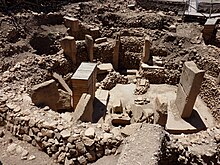


Colonnade 27 from Enclosure C (Layer 3) with the sculpture of a predatory fauna

Colonnade with the sculpture of a fox
Because of its strategic location at the intersection of Asia and Europe, Anatolia has been the center of several civilizations since prehistoric times. The Anatolian hypothesis, get-go adult by British archaeologist Colin Renfrew in 1987, proposes that the dispersal of Proto-Indo-Europeans originated in Neolithic Anatolia. Information technology is the main competitor to the Kurgan hypothesis, or steppe theory, the more than favoured view academically. Neolithic settlements include Çatalhöyük, Çayönü, Nevali Cori, Aşıklı Höyük, Boncuklu Höyük Hacilar, Göbekli Tepe, Norşuntepe, Kosk, and Mersin.
Çatalhöyük (Key Turkey) is considered the most advanced of these, and Çayönü in the east the oldest (c. 7250–6750 BC). Nosotros have a good idea of the town layout at Çayönü, based on a cardinal square with buildings synthetic of stone and mud. Archeological finds include farming tools that suggest both crops and animal husbandry as well as domestication of the canis familiaris. Organized religion is represented by figurines of Cybele, the mother goddess. Hacilar (Western Turkey) followed Çayönü, and has been dated to 7040 BC.[6]
Chalcolithic (Copper) Age [edit]
Straddling the Neolithic and early Statuary Historic period, the Chalcolithic era (c. 5500–3000 BC) is defined past the offset metal implements made with copper. This age is represented in Anatolia by sites at Hacilar, Beycesultan, Canhasan, Mersin Yumuktepe, Elazig Tepecik, Malatya Degirmentepe, Norşuntepe, and Istanbul Fikirtepe.[7]
Bronze Age [edit]
The Statuary Age (c. 3300–1200 BC) is characterised past the apply of copper and its tin can alloy, statuary, for manufacturing implements. Asia Minor was one of the start areas to develop statuary making.
Early Statuary Age (3000–2500 BC) [edit]
Although the first habitation appears to have occurred as early as the 6th millennium BC during the Chalcolithic period, functioning settlements trading with each other occurred during the tertiary millennium BC. A settlement on a high ridge would go known as Büyükkaya, and later as the city of Hattush, the centre of this civilization. Later notwithstanding it would get the Hittite stronghold of Hattusha and is now Boğazköy. Remnants of the Hattian civilization accept been found both under the lower city of Hattusha and in the college areas of Büyükkaya and Büyükkale,[eight] Another settlement was established at Yarikkaya, most 2 km to the northeast.
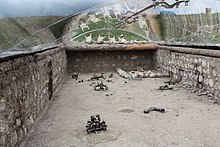
The discovery of mineral deposits in this part of Anatolia immune Anatolians to develop metallurgy, producing items such equally the implements found in the imperial graves at Alaca Höyük, about 25 km from Boğazköy, which it preceded, dating from 2400–2200 BC. Other Hattian centers include Hassum, Kanesh, Purushanda, and Zalwar.[9] [10] [11] [12] [13] During this time the Hattians engaged in trade with city-states such as those of Sumer, which needed timber products from the Amanus mountains.
Anatolia had remained in the prehistoric period until it entered the sphere of influence of the Akkadian Empire in the 24th century BC under Sargon of Akkad, specially in eastern Anatolia. However, the Akkadian Empire suffered problematic climate changes in Mesopotamia, as well as a reduction in bachelor manpower that affected trade. This led to its fall effectually 2150 BC at the hands of the Gutians.[14] The interest of the Akkadians in the region as far as it is known was for exporting diverse materials for manufacturing. Bronze metallurgy had spread to Anatolia from the Transcaucasian Kura-Araxes civilization in the late fourth millennium BC.[15] While Anatolia was well endowed with copper ores, there was no testify of substantial workings of the can required to make bronze in Bronze-Age Anatolia.[xvi]
Heart Bronze Age (2500–2000 BC) [edit]
At the origins of written history, the Anatolian plains inside the area ringed by the Kızılırmak River were occupied by the kickoff divers civilisation in Anatolia, a not-Indo-European indigenous people named the Hattians (c. 2500 BC – c. 2000 BC). During the eye Bronze Age, the Hattian civilization, including its capital of Hattush, continued to expand.[10] The Anatolian centre Bronze Age influenced the early Minoan civilization of Crete (3400 to 2200 BC) as evidenced past archaeological findings at Knossos.[17]
Tardily Bronze Age (2000–1200 BC) [edit]

Hattians [edit]
The Hattians came into contact with Assyrians traders from Assur in Mesopotamia such as at Kanesh (Nesha) well-nigh mod Kültepe who provided them with the tin needed to brand bronze. These trading posts or Karums (Akkadian for Port), have lent their name to a flow, the Karum Menstruation. The Karums, or Assyrian trading colonies, persisted in Anatolia until Hammurabi conquered Assyria and it vicious nether Babylonian domination in 1756 BC. These Karums represented split up residential areas where the traders lived, protected by the Hattites, and paying taxes in return. Meanwhile, the fortifications of Hattush were strengthened with construction of regal residences on Büyükkale.
Later on the Assyrians overthrew their Gutian neighbours (c. 2050 BC) they claimed the local resources, notably silver, for themselves. However the Assyrians brought writing to Anatolia, a necessary tool for trading and business concern. These transactions were recorded in Akkadian cuneiform on clay tablets. Records found at Kanesh use an advanced organization of trading computations and credit lines. The records also indicate the names of the cities where the transaction occurred.[fifteen]
Hittites [edit]

A drawing of rock-carved reliefs of a procession of Hittite deities in Yazılıkaya, Turkey.
The history of the Hittite civilization is known by and large from cuneiform texts found in the area of their empire, and from diplomatic and commercial correspondence found in diverse athenaeum in Egypt and the Heart East.
One-time Kingdom [edit]
Hattian civilization was also impacted by an invading Indo-European people, the Hittites, in the early 18th century BC, Hattush being burned to the footing in 1700 BC by King Anitta of Kussar after overthrowing Rex Piyushti. He and so placed a curse on the site and prepare upward his capital at Kanesh 160 km south east.[10] The Hittites absorbed the Hattians over the side by side century, a procedure that was essentially complete by 1650 BC. Somewhen Hattusha became a Hittite centre by the second one-half of the 17th century BC, and King Hattusili I (1586–1556 BC) moved his capital letter back to Hattusha from Neša (Kanesh).
The Old Hittite Empire (17th–15th centuries BC) was at its height in the 16th century BC, encompassing key Anatolia, north-western Syrian arab republic as far as Ugarit, and upper Mesopotamia. Kizzuwatna in southern Anatolia controlled the region separating the Hittite Empire from Syria, thereby greatly affecting trade routes. The peace was kept in accordance with both empires through treaties that established boundaries of control.
Middle Kingdom [edit]
Following the reign of Telipinu (c. 1460 BC) the Hittite kingdom entered a relatively weak and poorly documented phase, known as the Heart Kingdom, from the reign of Telipinu'southward son-in-law, Alluwamna (mid-15th century BC) to that of Muwatalli I (c. 1400 BC).
New Kingdom [edit]
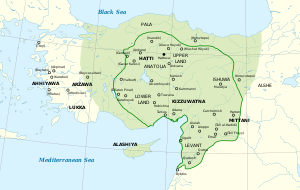
King Tudhaliya I (early 14th century BC) ushered in a new era of Hittite power, ofttimes referred to as the Hittite Empire. The Kings took on a divine office in Hittite gild and the Hittite peoples, often allied with neighbours such as the Kizzuwatna began to expand once more, moving into Western Anatolia, absorbing the Luwian state of Arzawa and the Assuwa League.
It was not until the reign of King Suppiluliumas (c. 1344–1322 BC) that Kizzuwatna was taken over fully, although the Hittites yet preserved their cultural accomplishments in Kummanni (at present Şar, Turkey) and Lazawantiya, due north of Cilicia.[eighteen]
In the 13th century, after the reign of Hattusili Iii (c. 1267–1237 BC), Hittite ability began to wane, threatened by Egypt to the South and Assyria to the E, effectively ending with Suppiluliuma Ii (c. 1207–1178 BC).
Syro-Hittite era [edit]
After 1180s BC, amid general turmoil in the Levant associated with the sudden inflow of the Ocean Peoples, and the collapse of the Bronze Age the empire disintegrated into several independent Syro-Hittite (Neo-Hittite) metropolis-states, some of which survived until equally late as the eighth century BC. In the Due west, Greeks were arriving on the Anatolian coast, and the Kaskas forth the northern Black Sea coast. Somewhen Hattusha itself was destroyed around 1200 BC and the age of Empires shifted to that of regional states as the Bronze Historic period transitioned into the Atomic number 26 Historic period.
Mycenaean presence [edit]
There is very little information about early Mycenaean presence in Anatolia. Miletus was conspicuously a centre of Mycenaean presence in Asia Small in the period c. 1450–1100 BC. The zone of intense Mycenaean settlement extends as far as Bodrum/Halicarnassus.[nineteen]
The Mycenaean sphere of influence in Asia Minor is also relatively restricted geographically: Intense Mycenaean settlement is to be found in the archaeological records simply for the region between the Peninsula of Halicarnassus in the southward and Milet [Miletus] in the north (and in the islands off this coastline, between Rhodes in the south and Kos – possibly also Samos – in the north).[19]
Attarsiya was a 15th–14th century BC military machine leader who was probably Greek. He conducted the first recorded Mycenaean military activeness on the Anatolian mainland. His activities are recorded in the Hittite athenaeum of c. 1400 BC.[20]
British archaeologist J.Grand. Melt studied the Greek historical tradition about the Carians, and drew attention to the many similarities between the Carians and the Mycenaeans.[21]
Fe Age [edit]
The Iron Age (c. 1300–600 BC) was characterised by the widespread use of iron and steel. Information technology is as well an historic period known for the development of various alphabets and early literature. Information technology formed the last phase of Pre-history, spanning the period between the collapse of the Bronze Historic period and the ascent of classical civilisation. In Anatolia, the dissolution of the Hittite Empire was replaced by regional Neo-Hittite powers including Troad, Ionia, Lydia, Caria and Lycia in the west; Phrygia, centrally and Cimmeria and Urartu in the northward due east, while the Assyrians occupied much of the southward east.

Regions of Anatolia, c. 500 BC. Aegean Greek settlements italicised
Western Anatolia [edit]
Troad [edit]
The Troad, on the Biga peninsula, was the northernmost of the Aegean settlements in this menstruation, all-time known for the legendary and historical metropolis country of Troy. There were probably settlements in this region dating back to 3000 BC and the various archeological layers representing successive civilisations are referred to every bit Troy I (3000–2600 BC) to Troy IX (1st century BC). Fe Age Troy corresponds to Troy VII-Viii, and coincides with the Homeric account of Troy and the Trojan Wars.
Aeolis [edit]

Ancient Greek settlements in western Anatolia (11th-eighth centuries BC). Halikarnassus was initially Dorian, so Ionian. Smyrna inverse from Aeolian to Ionian
Aeolis was an area of the north western Aegean coast, betwixt Troad and Ionia, from the Hellespont to the Hermus River (Gediz), west of Mysia and Lydia. By the 8th century BC the twelve nigh important cities formed a league. In the 6th century the cities were progressively conquered past Lydia, and and so Persia.
Ionia [edit]
Ionia was office of a group of settlements on the key Aegean coast divisional by Lydia to the east, and Caria to the south, known as the Ionian league. Ionians had been expelled from the Peloponnesus past the Dorians, and were resettled on the Aegean coastline of Anatolia past the Athenians to whose land they had fled. By the time of the concluding Lydian king, Croesus (560–545 BC) Ionia fell under Lydian, and then Western farsi rule. With the defeat of Persia past the Greeks, Ionia again became independent until captivated into the Roman province of Asia.
Lydia (Maeonia) [edit]
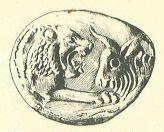
Lydian electrum coin, depicting a lion and bull.
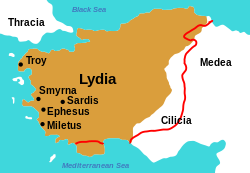
Map of the Lydian Empire under Croesus, sixth century BC
Lydia, or Maeonia as it was called before 687 BC, was a major part of the history of western Anatolia, beginning with the Atyad dynasty, who outset appeared around 1300 BC. Lydia was situated to the west of Phrygia and east of the Aegean settlement of Ionia. The Lydians were Indo-European, speaking an Anatolian language related to Luwian and Hittite.
The Heraclids, managed to dominion successively from 1185–687 BC despite a growing presence of Greek influences forth the Mediterranean coast. Equally Greek cities such every bit Smyrna, Colophon, and Ephesus rose, the Heraclids became weaker and weaker. The final male monarch, Candaules, was murdered by his friend and lance-bearer named Gyges, and he took over as ruler. Gyges waged war against the intruding Greeks, and soon faced by a grave problem as the Cimmerians began to pillage outlying cities inside the kingdom. Information technology was this moving ridge of attacks that led to the incorporation of the formerly independent Phrygia and its capital Gordium into the Lydian domain. It was not until the successive rules of Sadyattes and Alyattes, ending in 560 BC, that the attacks of the Cimmerians ended for expert.
Under the reign of the concluding Lydian king Croesus, Lydia reached its greatest expansion. Persia was invaded first at the Boxing of Pteria ending without a victor. Progressing deeper into Persia, Croesus was thoroughly defeated in the Battle of Thymbra at the hands of the Western farsi Cyrus Ii in 546 BC.[22]
Following Croesus' defeat, Lydia fell under the hegemony of Persia, Greece, Rome and Byzantium until finally being captivated into the Turkish lands.
Caria [edit]
Caria forms a region in Western Anatolia, south of Lydia, due east of Ionia and n of Lycia. Partially Greek (Ionian and Dorian), and perhaps partially Minoan. Caria became subject to Persia, Hellenic republic and Rome before being captivated into Byzantium. Remnants of the Carian culture grade a rich legacy in the s western Aegean. Caria managed to maintain a relative caste of independence during successive occupation, and its symbol, the double headed axe is seen as a marking of defiance and can exist seen inscribed on many buildings. The mausoleum at Halicarnassus (modern Bodrum), the tomb of the Western farsi Satrap Mausolus, was considered one of the Vii Wonders of the Aboriginal Earth. Other important relics include that of Mylasa (Milas) at ane fourth dimension capital of Caria and administrative seat of Mausolus, Labranda in the mountains loftier above Mylasa and Euromos (Herakleia) well-nigh Lake Bafa.
Lycia [edit]
Lycia formed the southernmost settlement in Western Anatolia on what is now the Teke peninsula on the western Mediterranean coast. There many historic Lycian sites include Xanthos, Patara, Myra, Pinara, Tlos, Olympos and Phaselis. Emerging at the stop of the Bronze Age every bit a Neo-Hittite league of city states whose governance model withal influences political systems today. Alternating between Persian and Greek dominion it eventually was incorporated into Rome, Byzantium and the Turkish lands.
Central Anatolia [edit]
Phrygia [edit]

Lydia, Phrygia, Cimmeria and Assyria, 9th-7th centuries BC
The westward-key area of Anatolia became the domain of the Phrygian Kingdom following the fragmentation of the Hittite Empire during the 12th century BC, existing independently until the 7th century BC, and strongly featured in Greek mythology. Although their origin is disputed, their language more resembled Greek (Dorian) than the Hittites whom they succeeded. Possibly from the region of Thrace, the Phrygians eventually established their capital at Gordium (now Yassıhüyük) and an important religious center at Yazılıkaya. Known as the Mushki to the Assyrians, the Phrygian people lacked central command in their style of government, and yet established an extensive network of roads. They also held tightly onto a lot of the Hittite facets of civilization and adapted them over time.[23]
Well known from ancient Greek and Roman writers is Male monarch Midas, the last male monarch of the Phrygian Kingdom. The mythology of Midas revolves around his ability to plow objects to gold by mere touch, equally granted by Dionysos, and his unfortunate meet with Apollo from which his ears are turned into the ears of a ass. The historical record of Midas shows that he lived approximately betwixt 740 and 696 BC, and represented Phrygia as a cracking king. Most historians at present consider him to exist King Mita of the Mushki as noted in Assyrian accounts. The Assyrians thought of Mita every bit a dangerous foe, for Sargon 2, their ruler at the time, was quite happy to negotiate a peace treaty in 709 BC. This treaty had no effect on the advancing Cimmerians in the East, who streamed into Phrygia and led to the downfall and suicide of King Midas in 696 BC.[24]
After Midas'southward decease, Phrygia lost its independence, becoming respectively a vassal land of its western neighbour, Lydia, Persia, Greece, Rome and Byzantium, disappearing in the Turkish era.
Eastern Anatolia [edit]
Cimmeria [edit]

Cimmerian invasions of Colchis, Urartu and Assyria 715–713 BC
Cimmeria was a region of north eastern Anatolia, appearing in the eighth century BC from the due north and east, in the face of the eastern Scythian accelerate. They continued to move west, invading and subjugating Phrygia (696–695 BC), penetrating equally far s as Cilicia, and due west into Ionia afterwards pillaging Lydia. Lydian campaigns between 637 and 626 BC effectively halted this advance. The Cimmerian influence progressively weakened and the last recorded mention is in 515 BC.
Urartu [edit]

Urartu 9th–6th centuries BC

Urartu nether Aramu 860–840 BC
Urartu (Nairi, or the Kingdom of Van) existed in north-eastward Anatolia, centered around Lake Van (Nairi Sea), to the due south of the Cimmerians and North of Assyria. Its prominence ran from its appearance in the 9th century until it was overrun past the Medes in the 6th century.
Urartu is start mentioned equally a loose confederation of smaller entities in the Armenian Highlands in the 13th to 11th centuries BC, simply was subject area to recurrent Assyrian incursions before emerging as a powerful neighbor past the 9th century BC. This was facilitated by Assyria'due south weak position in the eighth century BC. Urartu continued to resist Assyrian attacks and reached it greatest extent under Argishti I (c. 785–760 BC). At that time it included present solar day Armenia, southern Georgia reaching virtually to the Black Sea, due west to the sources of the Euphrates and south to the sources of the Tigris.
Following this Urartu suffered a number of setbacks. King Tiglath Pileser III of Assyria conquered it in 745 BC. Past 714 BC it was being ravaged by both Cimmerian and Assyrian raids. Afterward 645 BC Scythian attacks provided further issues for Urartu forcing it to become dependent on Assyria. Notwithstanding Assyria itself fell to a combined assail of Scythians, Medes and Babylonians in 612 BC. While the details of Urartu's demise are debated, it finer disappeared to exist replaced by Armenia. It was a Persian Satrapy for a while from the 6th century BC before condign an independent Armenia. To this 24-hour interval Urartu forms an important part of Armenian nationalist sentiment.
Assyria [edit]
In the Atomic number 26 Historic period Assyria extended to include south eastern Anatolia. Assyria, 1 of the cracking powers of the Mesopotamia region, had a long history from the 25th century BC (Statuary Age) until it concluding collapse in 612 BC at the end of the Iron Historic period. Assyria's Iron Age corresponds to the Middle Menstruation (resurgence) and the Neo-Assyrian Empire in its concluding 300 years, and its territory centered on what is modernistic day Iraq.
Assyria influenced Anatolian politics and civilisation from when its traders kickoff came into contact with Hattians in the late Statuary Historic period. By the 13th century BC Assyria was expanding to its north west at the expense of the Hittites, and to the north at the expense of Urartu. Assyrian expansion reached its tiptop under Tukulti-Ninurta I (1244–1208 BC), post-obit which information technology was weakened by internal dissent. The collapse of the Hittie Empire at the cease of the Statuary Historic period coincided with an era of renewed Assyrian expansion nether Ashur-resh-ishi I (1133–1116 BC) and shortly Assyria had added the Anatolian lands in what is now Syria to its empire. Tiglath-Pileser I (1115–1077 BC) then commenced incursions against the Neo-Hittite Phrygians, followed by the Luwian kingdoms of Commagene, Cilicia and Cappadocia.
With the death of Tiglath-Pileser I Assyria entered a period of decline during what is referred to equally the Ancient Dark Ages (1075–912 BC) in the region that corresponded to the collapse of the Bronze Age. The concluding 300 years of the Assyrian Empire (Neo-Assyrian Empire) from 911–627 BC saw a renewed expansion including attacks on the Neo-Hittite states to its north and west. Ashurnasirpal Ii (883–859 BC) extracted tribute from Phrygia while his successor Shalmaneser III (858–823 BC) too attacked Urartu forcing his Anatolian neighbours to pay tribute. After his death the land was torn by civil state of war. Assyrian power continued to wax and wane with periodic incursions into the Anatolian lands. Sennacherib (705–681 BC) encountered and collection back a new force in the region, the Greeks who attempted to settle Cilicia. His successor Esarhaddon (680–669 BC) was responsible for the final destruction of Urartu. Ashurbanipal (669-627 BC) and then extended Assyrian influence yet further placing Caria, Cilicia, Lydia and Cappadocia into vassalage.
Nevertheless Assyria plant its resources stretched to maintain the integrity of its vast empire and civil war again erupted following the expiry of Ashurbanipal. Vassal states stopped paying tribute, regaining independence. The weakened Assyrian state was at present faced by a new threat, a coalition of Iranian peoples to its due east and north, including Medes, Persians, Scythians and the Anatolian Cimmerians, who attacked Assyria in 616 BC. Ninevah, the capital, fell in 612 BC and the Assyrian Empire was finally swept abroad in 605 BC.
With the collapse of Assyria, ended not only the Iron Age, but also the era referred to as Pre-History, to make way for what has been variously described every bit Recorded History, or more specifically late Aboriginal History or Classical Civilization. However these terms are non precise or universal and overlap.
Run across likewise [edit]
- History of Europe
- History of the Middle East
- Timeline of Middle Eastern history
- Anatolianism
- Ancient kingdoms of Anatolia
- Ancient Regions of Anatolia
- Aboriginal Near Eastward
Notes [edit]
- ^ a b http://www.sci-news.com/archeology/science-stone-tool-turkey-02370.html
- ^ Suthan & 2009-2014, Paleolithic age harvnb fault: no target: CITEREFSuthan2009-2014 (help)
- ^ Manisa Museum, Republic of Turkey Civilisation government minister website
- ^ Martin Lockley, Gordon Roberts & Jeong Yul Kim. In the Footprints of Our Ancestors: An Overview of the Hominid Runway Record. Ichnos Volume fifteen, Outcome 3-4, 2008, pages 106-125
- ^ Suthan & 2009-2014, Mesolithic age harvnb mistake: no target: CITEREFSuthan2009-2014 (help)
- ^ Suthan & 2009-2014, Neolithic age harvnb fault: no target: CITEREFSuthan2009-2014 (assistance)
- ^ Suthan & 2009-2014, Chalcolithic age harvnb error: no target: CITEREFSuthan2009-2014 (help)
- ^ A Brief History of Hattusha/Boğazköy Archived 2012-05-27 at archive.today
- ^ The History Files: Hatti (Hattusa)
- ^ a b c Expedition in Ancient Anatolia: Hattians - First Civilizations in Anatolia
- ^ "The Joukowsky Plant of Archaeology: The Archaeology of Mesopotamia". Archived from the original on 2013-12-09. Retrieved 2012-02-18 .
- ^ The Hittites, their forerunners and their followers Archived 2012-08-03 at annal.today
- ^ Burney CA. Historical lexicon of the Hittites: Kültepe. Scarecrow Press, 2004, Lanham MD
- ^ Saggs, H.Westward.F. (2000). Babylonians. Academy of California Press. ISBN978-0-520-20222-1.
- ^ a b Freeman, Charles (1999). Arab republic of egypt, Greece and Rome: Civilizations of the Aboriginal Mediterranean. Oxford University Press. ISBN978-0-19-872194-ix.
- ^ Trevor Bryce, The Kingdom of the Hittites, rev. ed, 2005:nine.
- ^ C. Michael Hogan, Knossos fieldnotes, Mod Antique (2007)
- ^ Hawkins, John David (2000). Corpus of Hieroglyphic Luwian Inscriptions. Walter de Gruyter. ISBN978-3-11-014870-i.
- ^ a b Hajnal, Ivo; Posch, Claudia (2009). "Graeco-Anatolian Contacts in the Mycenaean Period". Sprachwissenschaft Innsbruck Institut für Sprachen und Literaturen . Retrieved 4 Apr 2015.
- ^ Kelder, Jorrit (2004–2005). "The Chariots of Ahhiyawa". Dacia, Revue d'Archéologie et D' Histoire Ancienne (48–49): 151–160.
- ^ Melt, J. M. (1959–1960). "Greek Archeology in Western Asia Minor". Archaeological Reports (6): 27–57
- ^ Duncker, Max (1879). The History of Antiquity, Volume III. Richard Bentley & Son.
- ^ Encyclopædia Britannica Online. "Phrygia". Retrieved 2007-x-19 .
- ^ Encyclopædia Britannica Online. "The legends and the truth well-nigh Male monarch Midas". Archived from the original on 2011-07-27. Retrieved 2007-10-19 .
References [edit]
- Cambridge Ancient History Online 14 vols. 1970-2000
Note: The original xi vol Cambridge Ancient History 1928-36 is at present available as free ebooks - Cambridge Companions to the Ancient Globe. 10 vols.
- Duncker, Max (1879). The History of Antiquity, Volume III. Richard Bentley & Son.
- Hornblower, Simon; Antony Spawforth (1996). The Oxford Classical Dictionary. Oxford University Press.
- McEvedy, Colin (1967). The Penguin Atlas of Ancient History. Penguin.
- Marek, Christian (2010), Geschichte Kleinasiens in der Antike. C. H. Beck, Munich, ISBN 978-3-406-59853-i (review: Thou. Weiskopf, Bryn Mawr Classical Review 2010.08.13).
- Suthan, Resat (2009–2014). "Historical". Anatolia. Thracian Ltd.
Source: https://en.wikipedia.org/wiki/Prehistory_of_Anatolia